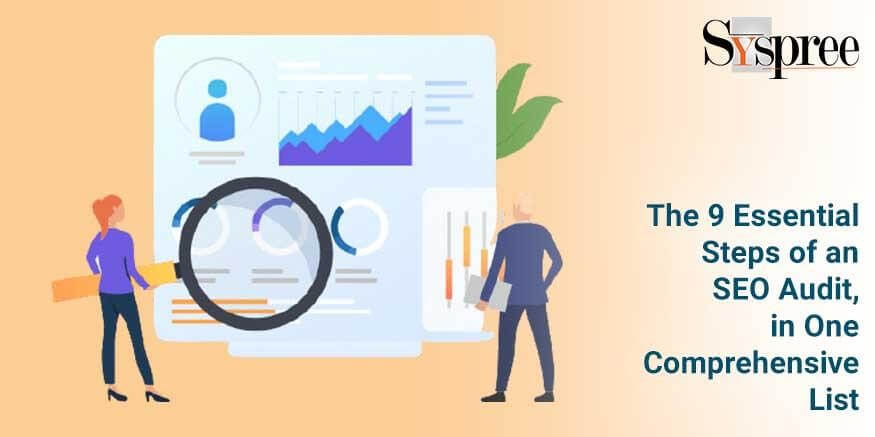SEO experts are aware of the importance of conducting regular audits; however, for those who have only an elementary understanding of SEO, it might seem like a daunting endeavor. But, in the digital age, it’s important to be aware of this. We’ll provide you with suggestions for conducting one SEO Audit and learn about the most recent tools and tips.
What is the exact purpose of a Search Engine Optimization Audit or SEO audit? It’s a method of assessing the condition of your website to avoid spam and offer recommendations on how you can improve the site.
The best SEO company states that SEO audits are essential due to a variety of reasons, chiefly due to the fact that Google alters its algorithm regularly according to new technologies and search trends. Conducting an extensive SEO audit is a crucial beginning point for any digital marketer, whether you conduct it internally or outsource the job.
This is because it allows you to evaluate your current SEO activities, regardless of how extensive or infrequent they may be, and take immediate action based on this information. Check out the brilliant search engine optimization packages in Mumbai.
What is the importance of an SEO audit?
It is crucial to examine a site’s overall health to ensure its functioning within an internal and external context. It is essential to conduct an internal examination of various aspects, such as the anchor text, sitemap, or even the social media platform.
It’s a big deal to speed up loading times, and a complete audit can reveal some errors you must take care of. One reason why taking this step is vital is to ensure that Google is not disqualifying you for doing something that could harm the ranking of your website. Many tiny details can cause this, even if you’re an SEO expert.
You could be doing it without even knowing. If you receive an audit from an outside source that is thorough, you’ll get information about the best practices for your website’s content, linking, and more. Visit the leading SEO company in Mumbai.
Conducting a complete SEO audit can be quite difficult and technical. You will find numerous detailed instructions on how to carry out one. It may seem the least enjoyable thing to do, even if you’re not an expert. However, it can increase profits in ways you’d never think of when done correctly.
It is essential to examine the performance of your website on a regular basis. You can use the tools for the SEO audit once a month and have an expert check your website annually.
The steps of an SEO Audit
Several essential steps are required during an SEO audit to ensure maximum efficiency. You can get help with this SEO audit from a top-notch digital marketing company. Let’s take a look at each of them more in-depth.
1. Crawling and site audits

Crawling and site audits
So, how do you conduct the SEO audit? Each successful audit begins by completing a thorough crawl of your site. This lets you assess the current state of your site and pinpoint any issues your site may be facing.
It’s a good idea to conduct an automated monthly scan to check the Core Web Vitals, such as loading speed, responsiveness, and visual stability of pages. This is frequently enough to reveal significant issues, including issues on-page that result in broken hyperlinks, page titles, meta-data, or duplicate content.
If you spot any serious problems, you should seek out a professional to conduct an in-depth review. A more thorough inspection should be performed every year. If you conduct an audit or scan, your site will be examined, and any bugs could be identified.
Additionally, it provides you with key indicators to improve your site’s SEO performance and increase the brand’s reputation.
Here are some of the most critical areas to take into consideration when performing an SEO audit:
- URL Structure: Are your URLs clean, unique, and simple?
- Content: Is it professional, well-written, formatted, and current?
- Meta Description: Is it distinctive on every page? Are they the correct length?
- Links: Do you have five links on average per page? Are they working?
- Images Are the descriptions accurate?
- Structure of the website Does it appear easy to read and navigate?
An in-depth analysis will examine your landing page’s layout and its relationship with other websites, the overall quality of the user experience, and the menu. You will also determine whether banners and ads work or are in the proper manner.
2. Page Speed

Page Speed
The best SEO company believes that the speed of the page is also a significant factor when performing the SEO assessment. Therefore it is essential to benchmark and test your site’s load speed. Speedy websites create an excellent user experience, while a slow site can cause more daily bounces. This isn’t optimal if your site is among your main customer conversion methods.
There are the most effective SEO analysis tools available which will aid you with speed. Utilize PageSpeed Insights to determine your site’s performance when rendered on mobile and desktop. The value of the speed test is the ability to identify which aspects of your site pose a problem from an SEO standpoint.
When you have identified the areas that need improvement, you can enhance the performance of your website.
3. Examine the Site Architecture
Another element that can help enhance your website’s SEO is to ensure it is built with a solid foundation. The more well-constructed the site’s structure is, the better the user experience, users visiting the site, and the robots that crawl it to determine its search rank.
It’s why having a clear, logical, well-organized structure evident in a precise sitemap (sent to your webmaster account on the tool) is vital. A well-constructed URL structure is also crucial. Be sure it is linked to your site’s hierarchy and adheres to simple and straightforward names, and avoid any numerals or symbols if you can. Explore the finest search engine optimization packages in Mumbai.
The third aspect of a robust website architecture is to ensure that your website’s main pages are included in the navigation menu at the top of your site, so bots and visitors to your site can quickly and easily find what they require quickly and easily.
To the same extent, it is important to include internal links to bring bots and users from one page on your site to another in a single step. With these methods, you’ll be able to create a strong website structure that will improve your SEO.
4. Review the Content on your Website
Content is a key SEO factor on the page and will significantly affect the efficiency of your website. Google prefers regular updates and unique information relevant to users’ requirements and preferences. Get to know what is currently working for Google Ranking.
That means that you must ensure that your site’s content meets this guideline’s requirements so that you can benefit from increased visibility for your brand and better rankings. Content SEO audit is essential; therefore, check the content you have already published and put your SEO mask on when writing new content.
When writing content, it is essential to use keywords in a consistent, natural way. It is important to balance the use of specific keywords without sending your message to the world as spammy. When it comes to making content for SEO, quality and value are essential, and only a brilliant digital marketing company can help you with this.
Utilize a content calendar to track relevant keywords within each format of content, and be aware of SEO and content marketing developments to ensure that you’re up-to-date.
5. Make sure you have your tags.
Short and descriptive title tags effectively convey the website’s intent that is being discussed. Search engines will remove the longer titles. Therefore, the shorter ones are better. Make sure you include relevant keywords whenever you can.
Meta-tags are used to provide an overview of the website’s content. Optimizing them can motivate a searcher to click on your page in a search result to your site. Alt Tags for Images are text description, which is vital for crawlers to crawl websites.
Suppose you have accurate descriptions of your site’s images (and also, make sure to use keywords that are targeted when it seems natural). In that case, it will dramatically affect your SEO and, in turn, your accessibility to the internet.
Regarding other vital tags, ensure that each of your pages has the rel=”canonical” hyperlink in the HTML of your site to avoid duplicate content issues, and blog post tags aid in organizing your website’s content to make it easier for crawlers to find it as long as you own blogs of course. If you plan to launch the blog, read how a blog submission helps SEO!
6. Verify your Backlinks

User Experience
Sometimes, being who you are is more important than what you know. Search engines frequently use the calibre of websites that link to your website to determine how good and valuable it is to users. In the past, there was an activity known as “link farming,” which involved the exchange of reciprocal links with other websites to boost SEO.
As the years have passed, the SEO method has become more refined, and algorithms have evolved to become more sophisticated. When it comes to backlinks, concentrate on quality and not quantity, making it an effective backlink strategy. In addition, you must confirm that your links originate from various domains rather than the same site since this can affect your SEO.
7. Examine indexability issues.
Google results from searches come from the index, which is a collection that contains hundreds of billions of websites. Your site’s pages should be part of this index to have a chance at getting a position.
It’s also crucial to remove pages that don’t have value for searchers from Google’s indexes since SEO issues can result from this. Google isn’t able to index pages with this warning. Therefore, ensuring the pages differ from those you’d like indexed is essential. The best SEO company in Mumbai is knowledgeable about the indexability.
You should also check the indexability of URLs that are in the report.
8. Check for mobile-friendliness

Mobile-friendliness
Mobile-friendly is a ranking factor globally since Google switched to mobile-first indexing at the beginning of 2019. It is easy to check for mobile-friendliness. Visit Google’s Mobile Usability report in Google Search Console. It informs you if URLs contain errors that hinder mobile usability.
9. Make sure you check for issues with the sitemap.
A sitemap lists all the websites you want search engines to crawl. It should not include redirects, non-canonicals, or dead sites because they transmit confusing signaling to Google. To look for issues with your sitemap, visit Site Audit, click on the All issues report on the Site Audit, and scroll down to the “Other” section. The process of making a thousand optimizations generally starts with one stage – an SEO audit.
For the majority of SEO experts, a thorough SEO audit is the most crucial step after signing a new contract or joining an entirely new business. It is important to be aware of the places you are currently in to get to where you’d like to be.
This is why SEO audits come in. The place you’d like to be is where people are looking for you, whether it’s your products or services or even the things you’re knowledgeable about. So, maximizing your exposure in search results from Google, as well as other engines for search, is crucial. An SEO audit can be your plan of action for getting there.
An SEO audit will uncover issues on any site’s SEO which means you can fix these issues and begin ranking in the right place.
Conclusion:
Conducting this SEO audit will give you three areas to focus on to increase SEO.
- Issues with SEO technical: fixing these issues can boost your website’s overall performance on search engines.
- On-page SEO issues to be resolved: these can increase the number of organic clicks.
- Opportunities for content: These can rank pages better and for more relevant keywords.
An SEO audit will help you develop an effective strategy before the beginning of your new project or launch of a website and is an essential element of maintaining your achievement.
An SEO Audit can help identify problems as fast as possible, and you’ll be able to solve issues that hinder your website from reaching its maximum potential. It is possible to audit different categories, and you’ll get valuable insight into the overall health of your website by following these steps. If you liked this post, check out our earlier one on 3-Tier Blogging Strategy: An Effective Step-by-Step Guide.








Great content! Awesome insights on SEO Audit!
The blog related to SEO is very helpful and the steps are very useful to do SEO audit.
Very excellent blog on the essential steps of an SEO audit for a website. Keep sharing your blogs, Thank you.
Thank you for your kind words